I visited the Yankee Fork Gold Dredge and Custer City (Ghost Town) on July 3, 1997. I headed up the Yankee Fork of the Salmon River to the town of Bananza, Idaho, another old mining ghost town. Only a few tumble down log buildings remain. The Yankee Fork is close to the Frank Church River of No Return Wilderness area. The nearest town, Stanley, is 22 miles from the dredge. See map here.
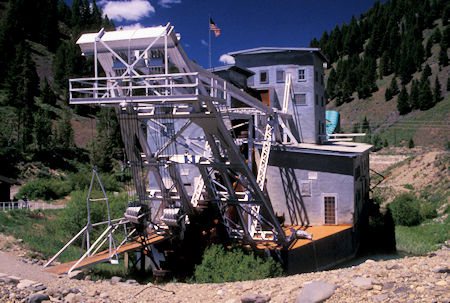
Yankee Fork Dredge - 1997
Nearby is the Yankee Fork Gold Dredge which has been fixed up and is open for tours. It was donated to the Forest Service. Information here.
In 1939 the Silas Mason company out of New York was looking for a place to invest some money to help out the economy. After doing some surveying they picked Yankee Fork valley as a place to do some dredging for gold. It was estimated that there was 11 million dollars of gold to be had in the 5 1/2 mile claim.
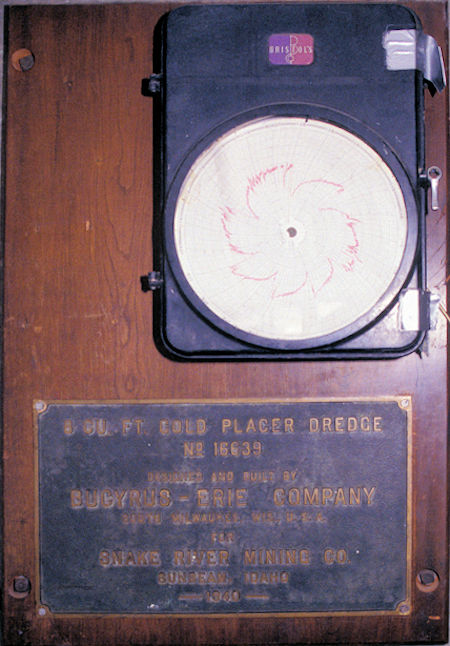
Yankey Fork Dredge name plate and motion tracking graph
They then contracted with Bucyrus Erie to build the dredge. All the material came from Milwaukee by railway to the town of Mackay then loaded on trucks and made the difficult journey to the construction site. The pontoons and superstructure were built in Boise and trucked over Galena summit to this location. Started on the 1st of April 1940 and finished on the 24th of August 1940.
The dredge is 988 tons, 112 ft long x 54 ft wide x 64 ft high and has a draft of 8 ft. It has seventy-one (71) 8 cubic foot buckets; each one weighs a little over a ton. The dredge is powered by two (2) Ingersoll-Rand diesel engines each producing 350 HP at that elevation.
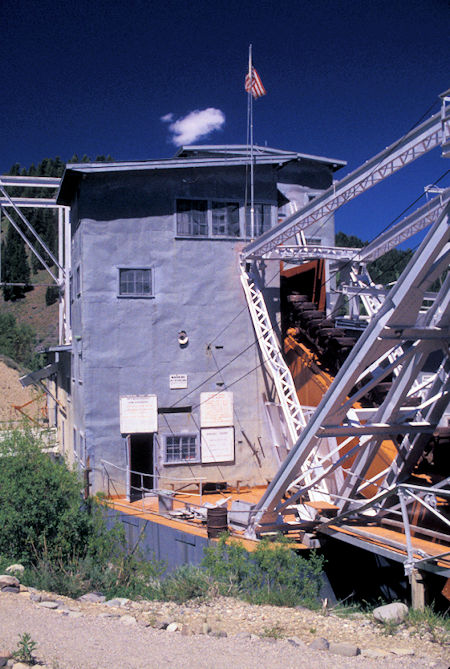
Yankee Fork Dredge - 1997
The dredge ran from 1940 to 1952 stopping once from late 1942 until early 1946 for WWII and then again in 1947 when Snake River Mining Co (subsidiary of Silas Mason) decided they were not making enough money and put it up for sale.
In 1949 J.R. Simplot and a partner in mining, Fred Baumhoff, bought the dredge for $75,000 and started it up again in April of 1950. In 1952 Simplot ran out of original claims so leased a small section from the Morrisons; when they completed that section they shut the dredge off and walked away.
Later in 1953 Morrison ask them to remove the dredge, or pay rent as the dredge still sat on Morrison's claim, and so Simplot's men started it up and dug themselves to the current position where it has sat ever since.
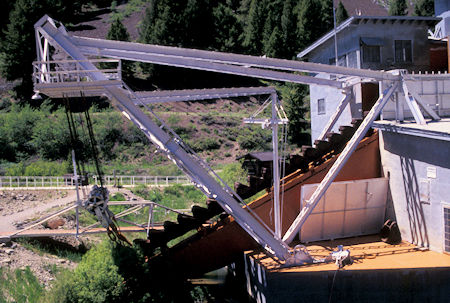
Yankee Fork Dredge bucket line
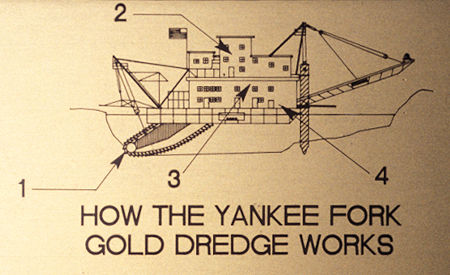
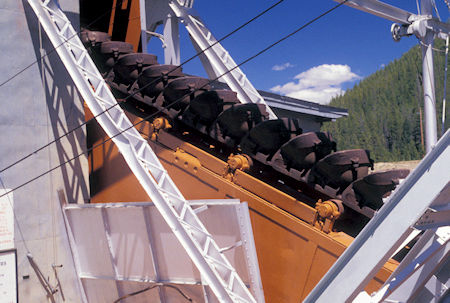
Yankee Fork Dredge bucket line
This dredge has a chain of 71 buckets, each weighing just over a ton. The pins holding them together weight 195 lbs. The hexagonal "upper tumbler" is powered by a 200HP electric motor which rotates the bucket line around the 89 foot long "ladder" which has a round "lower tumbler" and can dig 37 feet deep. A ladder hoist using a 100HP electric motor raised and lowered the digging apparatus.
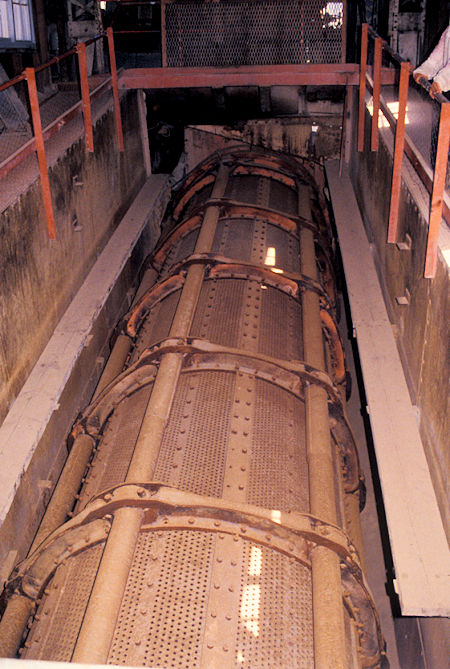
Rotating CYLINDRICAL SCREEN where rocks larger than 5/8" are separated to discard
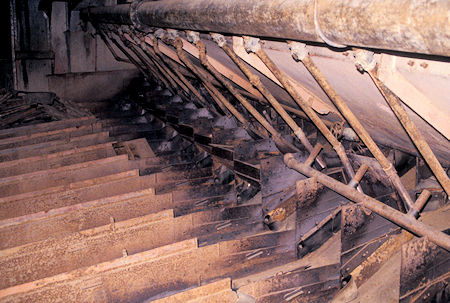
Yankee Fork Dredge - sluice boxes that separate out the gold
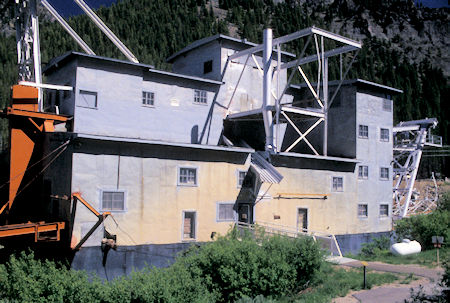
Side of Yankee Fork Dredge showing chute where large rocks exit
When a rock large enough to damage the revolving screen reaches the top of the bucket line, it is caught and ejected into the chute on the side of the dredge. As the large rock dropped, water would splash thirty feet high. You can still see the brown stain on the side of the dredge where the muddy water drenched the boat.
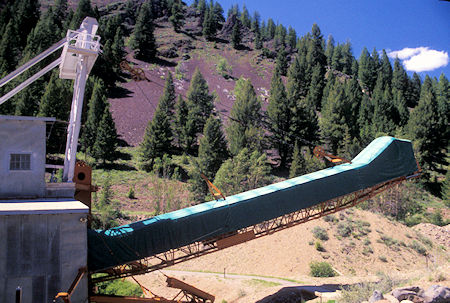
Yankee Ford Dredge stacker
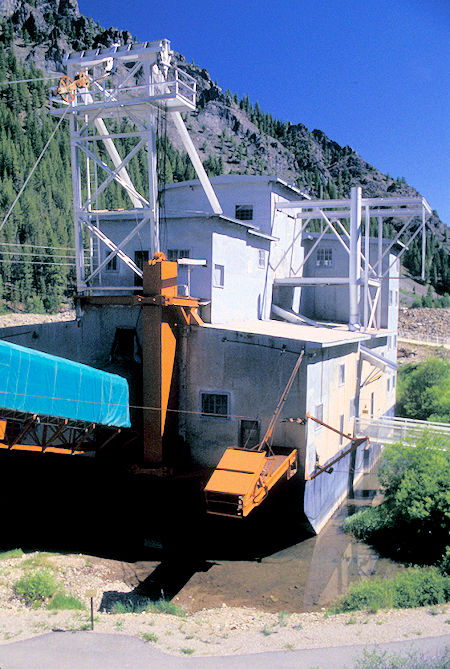
Yankee Fork Dredge - tail sluice
The stacker juts out from the dredge 115 feet and is used to dump the larger gravel far behind the dredge. Early dredges with short stackers were sometimes sunk by rocks wearing holes in their hull.
The 42 inch wide belt is powered by a 25HP electric motor and is supported on rollers. When the dredge is digging in heavy rocks, the jerking motion at the end of the stacker can get quite violent, giving the stern oiler who greased the rollers quite a ride.
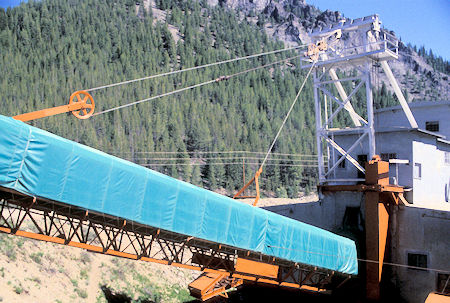
Yankee Ford Dredge stacker
8400 gallons of water per minute washed the gold from the rocks, broke up clay balls and transported the "fines" over the riffles in the sluice boxes.
This water is pumped from the dredge pond by three huge pumps and returned via the tail sluices on either side of the dredge (one shown in the picture above with extension folded up), carrying with it all the sand, small gravel and soil.
These fines fill in around the 17 ton SPUD (in the tall brown box next to the stacker) and help it resist the backward thrust of the dredge.
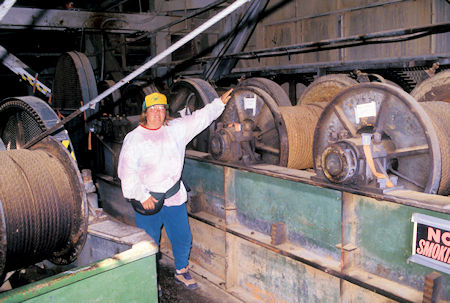
Yankee Fork Gold Dredge - hoist machinery
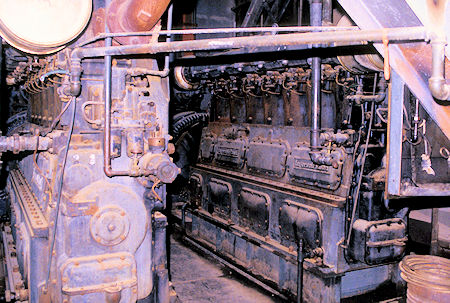
The large diesel engines that powered the dredge
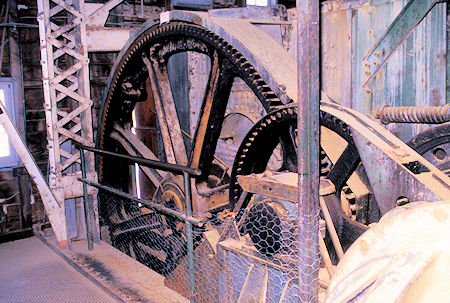
Yankee Fork Dredge machinery
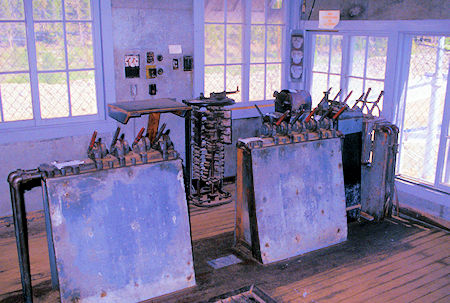
Operating controls of the Yankee Fork Gold Dredge
The Yankee Fork Gold Dredge is one of the best preserved and presented dredges in the lower 48 states. It was donated to the U.S. Forest Service by J.R. Simplot in 1966, and in 1980 the Yankee Fork Gold Dredge Association began providing guided tours to the public.
It dredged about six miles of the Yankee Fork and a short way up Jordan Creek between 1940 and 1952. It ran 24 hours a day most of the time - was shut down during most of World War II.
Some 11+ million dollars of gold was believed to be available and the dredge did quite well. Interestingly, the gold bars they produced were sent to the U.S. Mint via Parcel Post - it is illegal for a citizen to hold gold (except jewelry) so they weren't worried about it being stolen - a thief would have no one to sell it to.
The tour was very well done and I learned a lot about how the dredge operated. It is pretty much intact which made it more interesting. Took only a three man crew to run it each shift. The noise could be heard two miles away.
One of the people in the tour group was from the Mojave Dessert area and his dad had been involved in mining. He added some knowledge to the discussion. He was also familiar with the Sumpter Valley Dredge which I had seen in 1996. Both are of similar size and design but the Sumpter one wasn't open for tours yet in 1996.
Nearby is the historical mining town of Custer City with many interesting things worth seeing.
A detailed history of this area will be found here: History on Yankee Fork Road - Bonanza, Custer, & the Yankee Fork Dredge
The Yankee Fork Gold Dredge in Idaho is one of the best preserved and presented California-type bucket-line gold dredges in the lower 48 states. Running for seven years between 1940 and 1952 she and her crew extracted over one million dollars of feather gold for the Snake River Mining Company.
Vandals stripped her of all precious equipment and metals while she sat idle between 1952 and 1980. The Yankee Fork Gold Dredge Association was formed in 1980 to preserve this massive piece of our mining history. Interior tours are provided by volunteers each summer between Memorial Day and Labor Day.
Our exploration and knowledge of the Yankee Fork Gold Dredge was greatly enhanced by our two volunteer guides, Rich Allen and Earl VanPatten. They made us feel like family during our four hour visit. The information presented was custom tailored to our interests and time allotted. The interior tour should not be missed by any historical or mining enthusiast.
For more information please visit http://yankeeforkdredge.com/
This sequence was captured with a Canon Vixia HFS-100 camera and edited with Adobe Premier Pro 6.
Music used: "Lost Frontier" by Kevin MacLeod (incompetech.com)
Licensed under Creative Commons: By Attribution 3.0
http://creativecommons.org/licenses/b...
Direct Link: http://incompetech.com/music/royalty-....
ISRC: USUAN1300039
© 2013 Kevin MacLeod